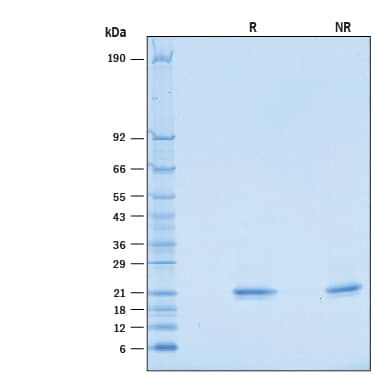Recombinant Mouse IFN-alpha 2/IFNA2 Protein, CF
R&D Systems, part of Bio-Techne | Catalog # 10149-IF

Key Product Details
Product Specifications
Source
Human embryonic kidney cell, HEK293-derived mouse IFN-alpha 2/IFNA2 protein
Cys24-Glu190
Cys24-Glu190
Purity
>95%, by SDS-PAGE visualized with Silver Staining and quantitative densitometry by Coomassie® Blue Staining.
Endotoxin Level
<0.10 EU per 1 μg of the protein by the LAL method.
N-terminal Sequence Analysis
Cys24
Predicted Molecular Mass
19.3 kDa
SDS-PAGE
18-22 kDa, under reducing conditions
Activity
Measured in an anti-viral assay using L-929 mouse fibroblast cells infected with encephalomyocarditis (EMC) virus. Vogel, S.N. et al. (1982) Infect. Immunol. 38:681.
The ED50 for this effect is 20-200 pg/mL.
The ED50 for this effect is 20-200 pg/mL.
Scientific Data Images for Recombinant Mouse IFN-alpha 2/IFNA2 Protein, CF
Recombinant Mouse IFN-alpha 2/IFNA2 Protein Bioactivity
Recombinant Mouse IFN-alpha 2/IFNA2 (Catalog # 10149-IF) suppresses viral activity on L-929 mouse fibroblast cells infected with encephalomyocarditis (EMC) virus. The ED50 for this effect is 20-200 pg/mL.Recombinant Mouse IFN-alpha 2/IFNA2 Protein SDS-PAGE
2 μg/lane of Recombinant Mouse IFN-alpha 2/IFNA2 (Catalog # 10149-IF) was resolved with SDS-PAGE under reducing (R) and non-reducing (NR) conditions and visualized by Coomassie® Blue staining, showing bands at 18-22 kDa.Formulation, Preparation and Storage
10149-IF
| Formulation | Lyophilized from a 0.2 μm filtered solution in PBS. |
| Reconstitution | Reconstitute at 100 μg/mL in PBS. |
| Shipping | The product is shipped with polar packs. Upon receipt, store it immediately at the temperature recommended below. |
| Stability & Storage |
Background: IFN-alpha 2/IFNA2
References
- Pestka, S. (2007) J Biol Chem. 282:20047.
- Paul, F. et al. (2015) Gene. 567(2):132.
- Oritani, K. et al. (2001). Cytokine & Growth Factor Reviews, 12:337.
- Pesch, V. et al. (2004). Journal of Virology, 78:8219.
- Wang, Y.X. et al. (2007) Am J Physiol Heart Circ Physiol. 293:H69.
- Schlaepfer, E. et al. (2019) Am Soc for Microbiology 4:e00637.
Long Name
Interferon alpha 2
Alternate Names
Ifa2, IFNA2, IFNA2a, IFNA2b, IFNA2c, IFNAA, IFNalpha 2
Gene Symbol
IFNA2
UniProt
Additional IFN-alpha 2/IFNA2 Products
Product Documents for Recombinant Mouse IFN-alpha 2/IFNA2 Protein, CF
Product Specific Notices for Recombinant Mouse IFN-alpha 2/IFNA2 Protein, CF
For research use only
